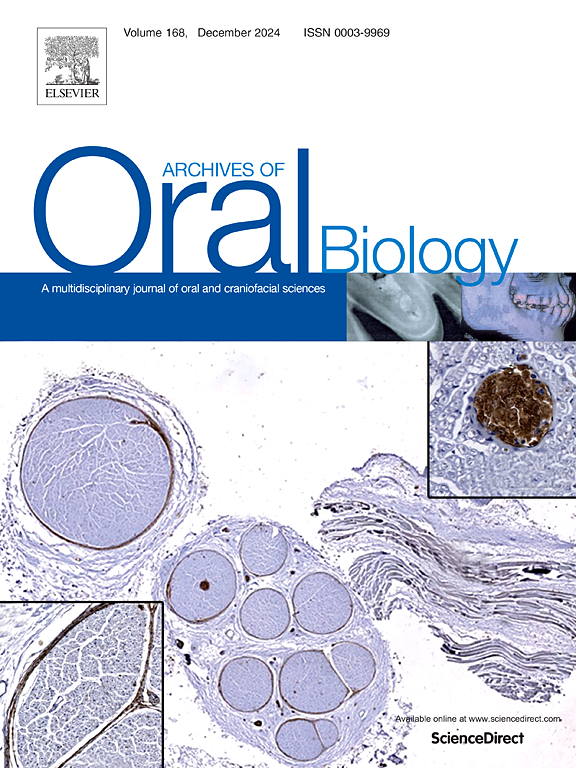How malocclusion interferes with tissue inhibitor of metalloproteinase-1 expression and morphology of the articular cartilage of the mandible in female rats
IF 2.2
4区 医学
Q2 DENTISTRY, ORAL SURGERY & MEDICINE
引用次数: 0
Abstract
Objective
The purpose of this study was to investigate morphological alterations and tissue inhibitor of metalloproteinase-1 expression in the articular cartilage of the mandible under conditions of experimentally induced malocclusion.
Design
Twenty-four 8-week-old female Wistar rats were used and divided into control and experimental groups with two different treatment periods (2 and 4 weeks). Sagittal malocclusions were orthodontically created, causing mesial movement of the first molars and distalization of the third molars unilaterally and on opposite sides of the arches. Sagittal sections of the articular cartilage of the mandible were subjected to hematoxylin and eosin and immunohistochemistry for tissue inhibitor of metalloproteinase-1. Chi-square and Mann![]() Whitney U tests were applied.
Whitney U tests were applied.
Results
Animals treated for 2 and 4 weeks showed morphological alterations in articular cartilage of the mandible. The main findings were thickening of the posterior third, layer derangement, osteoclast activity and osteophyte formation. Among the cellular aspects, the presence of chondrocytes with condensed nuclei and cytoplasm reduction were observed. The enzyme in control animals was observed only in the mature layer. Treated animals showed immunopositive cells in the proliferative and mature layers, and in the 2-week treated group, the posterior third of the cartilage had more immunolabeled cells than control (P=0.0291).
Conclusions
The occlusal disorder caused morphological changes in articular cartilage of the mandible, probably due to the attempt to adapt to the new condition. Tissue inhibitor of metalloproteinase-1 expression may play a role as an initial modulator in the biological events observed in articular cartilage of the mandible.
错牙合畸形如何影响雌性大鼠下颌骨关节软骨中金属蛋白酶组织抑制剂-1的表达和形态
设计采用24只8周大的雌性Wistar大鼠,分为对照组和实验组,治疗周期分别为2周和4周。通过正畸造成矢状错颌,使第一磨牙向中侧移动,第三磨牙向远侧移动,单侧且位于牙弓的两侧。对下颌骨关节软骨的矢状切片进行苏木精、伊红和组织金属蛋白酶抑制剂-1的免疫组化。结果治疗 2 周和 4 周的动物下颌骨关节软骨发生了形态学改变。主要表现为后三分之一增厚、层错位、破骨细胞活性和骨赘形成。在细胞方面,观察到软骨细胞的细胞核浓缩,细胞质减少。对照组动物仅在成熟层中观察到酶。结论咬合紊乱导致下颌骨关节软骨发生形态学变化,可能是由于试图适应新的条件。组织金属蛋白酶抑制剂-1的表达可能在下颌骨关节软骨中观察到的生物事件中起到了初始调节剂的作用。
本文章由计算机程序翻译,如有差异,请以英文原文为准。
求助全文
约1分钟内获得全文
求助全文
来源期刊

Archives of oral biology
医学-牙科与口腔外科
CiteScore
5.10
自引率
3.30%
发文量
177
审稿时长
26 days
期刊介绍:
Archives of Oral Biology is an international journal which aims to publish papers of the highest scientific quality in the oral and craniofacial sciences. The journal is particularly interested in research which advances knowledge in the mechanisms of craniofacial development and disease, including:
Cell and molecular biology
Molecular genetics
Immunology
Pathogenesis
Cellular microbiology
Embryology
Syndromology
Forensic dentistry
 求助内容:
求助内容: 应助结果提醒方式:
应助结果提醒方式:


